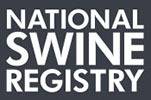In my last Industry Insightspost, we talked about the “Crate Debate.” This is just one of a handful of animal welfare debates facing our industry, and recent research from Purdue University yielded some “red flag” results for pork producers. Dr. Nicole Olynk Widmar (Agricultural Economics), Dr. Candace Croney (Animal Science) and Melissa McKendree (Agricultural Economics) conducted a survey of U.S. consumers related to perceptions of livestock – specifically pork – production. What they found may come as a shock.
Of the 798 survey participants, nearly one-third had never been to a farm that raised animals for the food system, and only 31 percent had visited such a farm within the last five years – which is representative of the nearly 98 percent of Americans who are not directly involved in agricultural production.
These researchers also looked at the consumers’ sources of information regarding animal welfare issues. This chart breaks down the responses:
There are a few important take-away messages from this.
When asked which sources they frequented the most, they cited the Humane Society of the United States (HSUS) and the People for the Ethical Treatment of Animals (PETA). In fact, more people turned to the HSUS and PETA for animal welfare information than industry groups, government agencies and scientific sources combined. (Source)
This is not good news for those of us in animal agriculture. However, there is another number that caught my eye…
56% of respondents indicated that they did not have a source for animal welfare information. (Source)
This tells us that there is an untapped group of consumers that we can reach with the positive story about pork production. Why is this important?
Fourteen percent of consumers stated that they had reduced pork consumption by an average of 56 percent from their previous consumption over the past three years due to animal welfare concerns. (Source)
If these numbers are a true reflection of the U.S. population, that adds up to a lot of pork! And at the end of the day, the concern is both the ineffectivenessof communication between the ag industry and consumers, as well as the effectivenessof the messages coming from animal welfare organizations.
This is not to say we are not trying to improve our connection with consumers. In fact, in the latest issue of Seedstock EDGE, you will find a story about Operation Main Street – a training platform introduced by The Pork Checkoff in 2004. Through this program, swine producers across the nation are connected with local community groups to present information about modern pork production. This has become a forum where consumers can ask specific questions about production practices, the safety of pork and other important topics in the swine industry.
This is just one example of many where the agricultural community is reaching out to educate consumers about what exactly it is we do. As we move forward, it will be important to keep asking ourselves not if we are doing enough, but also if we are doing it the right way. If one method of communication doesn’t seem to be helping us reach our audience, we will have to change our tactics. Otherwise, that 56% could swing the other way.
Click here to read the article on the National Hog Farmer website, which also covers survey results regarding the concern toward different segments of operation within the swine industry and opinions toward specific production practices.
What do you think we need to do to reach consumers with the story of pork production? To share your thoughts, comment below or shoot me an e-mail. Find my contact info here.



